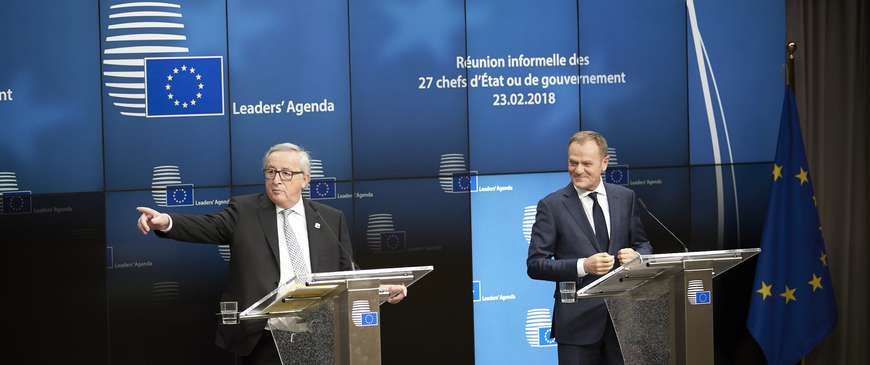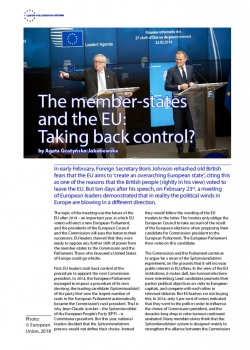
The member-states and the EU: Taking back control?
The irony of Brexit is that the EU is becoming more British just as the UK is leaving the EU.
In early February, Foreign Secretary Boris Johnson rehashed old British fears that the EU aims to "create an overarching European state", citing this as one of the reasons that the British people (rightly in his view) voted to leave the EU. But ten days after his speech, on February 23rd, a meeting of European leaders demonstrated that in reality the political winds in Europe are blowing in a different direction.
The topic of the meeting was the future of the EU after 2019 – an important year, in which EU voters will elect a new European Parliament, and the presidents of the European Council and the Commission will pass the baton to their successors. EU leaders showed that they were ready to oppose any further shift of power from the member-states to the Commission and the Parliament. Those who favoured a United States of Europe could go whistle.
EU leaders look set to take control over who becomes the next European Commission president in 2019.
First, EU leaders took back control of the procedure to appoint the next Commission president. In 2014, the European Parliament managed to impose a procedure of its own devising: the leading candidate (Spitzenkandidat) of the party that won the largest number of seats in the European Parliament automatically became the Commission’s next president. That is why Jean-Claude Juncker – the Spitzenkandidat of the European People’s Party (EPP) – is Commission president. But this year, national leaders decided that the Spitzenkandidaten process would not define their choice. Instead they would follow the wording of the EU treaties to the letter. The treaties only oblige the European Council to take account of the result of the European elections when proposing their candidate for Commission president to the European Parliament. The European Parliament then votes on this candidate.
The Commission and the Parliament continue to argue for a rerun of the Spitzenkandidaten experiment, on the grounds that it will increase public interest in EU affairs. In the view of the EU institutions, it makes dull, low-turnout elections more interesting. Lead candidates promote their parties’ political objectives on visits to European capitals, and compete with each other in televised debates. But EU leaders are not buying this. In 2014, only 5 per cent of voters indicated that they went to the polls in order to influence the choice of Commission president, and the decades-long drop in voter turnout continued unabated. Many member-states think that the Spitzenkandidaten system is designed mainly to strengthen the alliance between the Commission and the Parliament, even at the cost of the EU’s democratic legitimacy. As Donald Tusk, the president of the European Council, argued after the February meeting, the Spitzenkandidaten system robbed the Commission president of his usual ‘dual legitimacy’: the president is meant first to be proposed by democratically-elected national leaders in the European Council; and then elected by MEPs. The Spitzenkandidaten system, however, forces the European Council to nominate a candidate pre-selected by the pan-European political parties.
The Commission and Parliament argue that #Spitzenkandidaten process increases public interest in EU affairs but member-states are not buying it.
European leaders cannot force the political parties to scrap the Spitzenkandidaten process altogether. The majority of the current leaders belong to political parties which are fully committed to the Spitzenkandidaten system. The dominant EPP, with nine current prime ministers or presidents, will elect its lead candidate in Helsinki in November 2018. Still, member-states’ leaders look set to take control over who their parties nominate as candidates. Leaders will encourage their parties to support candidates who stand a good chance of getting support across the political spectrum in the European Council. And if the parties ignore this advice, leaders can always resort to a hardline policy of ‘no automaticity’ and propose an alternative candidate for Commission president.
Second, EU leaders junked Juncker’s idea of creating a so-called double-hatted president for the EU. Juncker’s vision was that one day the Commission president should also chair European Council meetings. Although he can be under no illusions about member-states’ appetite for this, he believes that in the long run merging the posts of the European Council and Commission presidents will simplify the EU’s work, improve its efficiency and reduce inter-institutional rivalries.
Member-states demur. They think that Juncker is simply plotting another power grab for the Commission and indirectly for the Parliament. If the Commission president were in charge of chairing European Council meetings, he or she would probably insist that the Commission secretariat prepared the European Council’s agenda and conclusions. The work of the Commission president is supported by thousands of the institution’s officials, and he would want them to continue doing this job for him in his new capacity. But that would give the Commission great influence over what EU leaders discussed and decided.
Member-states junked Juncker's idea to create a double-hatted president because they think he is plotting another power grab.
The European Parliament would also win more power. Today, it is national parliaments that hold their prime ministers to account for what they decide in the European Council (though some do this more vigorously than others) and MEPs merely receive a report from the European Council president after the summits. But this could change significantly under a double-hatted system, because the Commission president is politically accountable to the European Parliament: MEPs not only elect the Commission president but can also throw him out, together with his or her fellow commissioners. National parliaments have no such power over the European Council president.
Third, EU leaders showed little appetite for reducing the number of commissioners in 2019. They will take a formal decision in March next year, but it now seems very unlikely that they will change the status quo. The EU treaties provide that the number of commissioners should equal two-thirds of the number of member-states, unless the European Council decides otherwise. Ahead of the Irish referendum on the Lisbon treaty in 2009, EU leaders decided to keep one commissioner per member-state. In his Sorbonne speech on September 26th 2017, Emmanuel Macron supported a leaner Commission, and suggested that France should set the example by giving up its own commissioner. But there was little sign at the leaders’ meeting that other member-states would follow Macron’s example. They might, in theory, agree that a smaller college would improve the Commission’s work; but having a ‘national commissioner’ makes it easier for each EU capital to navigate European politics (even if, formally speaking, the Commission may “neither seek nor take instructions from any government”). EU capitals prize ‘their’ commissioner all the more because they fear that the Spitzenkandidaten process will otherwise push the European Commission into the arms of MEPs.
The irony of #Brexit is that the EU is becoming more British just as the UK is leaving the EU.
Theresa May was not invited to attend the February meeting because the summit concerned the EU’s future post-Brexit. But if the British prime minister had been in the room that day, she probably would have welcomed the general direction of travel. The outcome of the leaders’ discussions chimes with the original British vision for the EU, whereby the member-states have a strong voice in EU decision-making, and keep the European Parliament and the Commission at arm’s length. But the irony of Brexit is that the EU is becoming more British just as the UK is leaving the EU.
Agata Gostyńska-Jakubowska is a senior research fellow at the Centre for European Reform.

